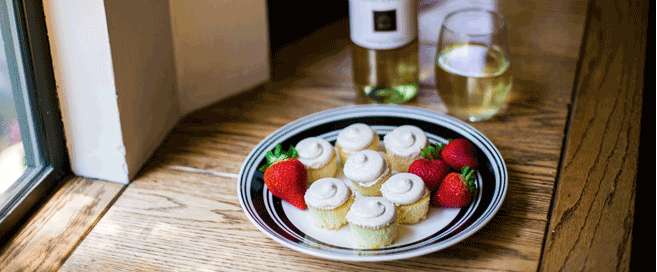Cooking with Wine 101
"I cook with wine. Sometimes, I even add it to the food." - Sign in Larry's Kitchen
Wine isn’t just great to sip while you cook; it’s a fantastic ingredient that will add subtle flavor and depth to any meal. But before you go emptying your glass into your pot, there are a few quick general guidelines for cooking with wine you should know about:
First, only cook with wine you would drink. Second, ensure you’re using just enough wine to enhance your dish but not so much that it becomes overpowering. Last, but certainly not least, don’t be afraid to experiment! You don’t have to be a wine connoisseur to create your perfect dish.
Now that we’ve got the basics out of the way, let’s explore how a splash of wine can make all the difference in your next meal!
Our 5 Top Tips for Cooking with Wine
1. It’s not just for savory dishes. Wine is an acidic ingredient and we all know can spice up sauces, marinades, and meats, and it's also a great substitute for fat as it helps dishes like fish retain moisture. However, it’s not just delicious in savory meals! Adding wine is also a brilliant way to dress up any dessert. Try adding chardonnay to cake batter or champagne to your next batch of cupcakes. Our sweets expert, Colleen recently made Chocolate-Covered Strawberry Sangria Jell-O Shots with wine!
2. Use discretion when choosing your bottle. We mentioned earlier that you should only cook with wine you would drink yourself. The tastier the wine is, the more it will enhance your cooking, and cheaper wine often contains additives that could end up spoiling an otherwise delicious dish. But you don’t need to reach for the most expensive bottle you own – just one that you wouldn’t mind sipping while you cook.
3. Allow enough time for the wine to simmer. A mistake that novices often make is not allowing the alcohol in the wine enough time to cook off. If a wine is added too late in the cooking process, it could impart a bitter and "raw" taste. Allow enough time for the wine to reduce and simmer before adding additional wine or stock. For pan sauces, reduce wine slowly over low heat to extract its full flavor. Keep in mind that the longer the wine simmers, the more alcohol will evaporate.
4. Pay attention to the tasting notes. It’s always good to experiment with pairing wines, but if you’ve never done it before, use the flavors in your meal as a guide. For bold and spicy flavors, choose an aromatic white wine with fruity notes like Riesling for balance. If you’re cooking a hearty stew or meat dish choose a complementary full-bodied red wine like Petite Syrah, Sherry or Port. Or, reach for a Cabernet or Merlot - they're great standbys!
5. Stock your wine rack. It’s always a good idea to have a few good wines on hand for cooking (or drinking). Some basic "no-brainer" wines to keep in your kitchen include Chardonnay for lighter dishes, like chicken or white fish; Pinot Noir for grilled beef or salmon; and full-bodied Cabernet for steak or lamb. These varietals are great for cooking and make enjoyable sipping wines!
If you've done it already, you know that cooking with wine is a fun and simple way to elevate any meal. With so many recipes and ideas available, options for creating your perfect meal are endless. Remember, although these basic guidelines will get you started, feel free to explore, experiment and break the rules every once in a while; perfecting your technique will only come through trial and error, and by understanding flavors and tastes! And if you're new to the concept of cooking with wine - welcome to the party, you're going to be hooked!
What are a few of YOUR favorite wine-involved recipes? Share with us on Facebook and Instagram!












